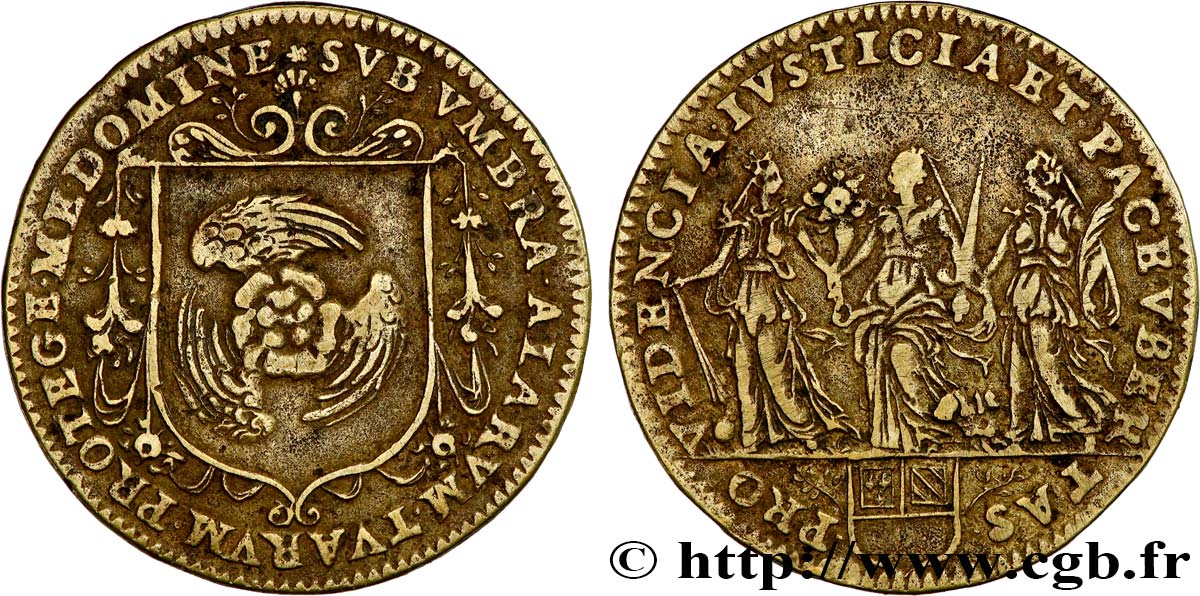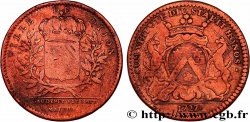fjt_713818 - DIJON (MAIRES DE ... et divers) Jacques Laverne n.d.
85.00 €
Количество
Добавить в корзину

Тип Jacques Laverne
Дата: n.d.
Металл: brass
Диаметр: 27,5 mm
Ориентация осей монеты: 6 h.
Вес: 5,18 g.
Век: lisse
Редкость: R1
Ссылки в каталоге: :
Происхождение:
Exemplaire provenant de la Collection MARINECHE
Лицевая сторона
Аверс: легенда: PROVIDENCIA. JUSTICIA. ET. PACE. VBERTAS.
Аверс: описание: La Providence, la Justice et la Paix debout ; à l’exergue les armes de Dijon.
Обратная сторона
Реверс: легенда: * SVB. VMBRA. ALARVM. TVARVM. PROTEGE. ME. DOMINE.
Реверс: Описание: Ses armes dans un écu orné.
Реверс: перевод: Protège-moi Maître sous l’ombre de tes ailes ouvertes.
Комментарий
Jacques Laverne est avocat, seigneur d’Athée et avait été maire en 1566. Il fut réélu le 21 juin 1587 puis continué le 21 juin 1588. L’arbre figuré sur les armes est un verne ou aune, arbre de bois blanc qui croît dans les lieux humides.
Les maires de Dijon
Dès l’époque de la naissance de la féodalité, la ville de Dijon possédait un maire et en général vingt magistrats municipaux, ou échevins. Ces magistrats sont confirmés en 1187, lorsqu’une charte de commune est accordée par le duc Hugues III. En 1192, pour la première fois, le maire dijonnais est élu.
A la fin du XIIIe siècle, ce maire prend le titre de vicomte maïeur, confirmé en 1477-1479 par Louis XI, qu’il gardera jusqu’en 1789. Depuis la fin du XVe siècle (1491), la charge de vicomte maïeur est anoblissante ainsi que celle d’échevin à compter du XVIe siècle. Le vicomte maïeur avait le droit de haute, moyenne et basse justice, le droit de scel et de visite. Les clefs de la ville lui sont confiées et il dirige les archers ainsi que les compagnies des sept quartiers, cette fonction militaire étant importante jusqu’au XVIIe siècle.
Fonction élective, le vicomte maïeur est élu par les habitants, ni mendiants, ni étrangers, qui payent la taille, en général la veille de la Saint-Jean. Cette élection a lieu sur le parvis de l'église saint Philibert. A partir de 1669, il est permis au maire de porter "une robe longue de satin plein, de couleur violet, doublée de satin rouge cramoisi, comme le prévôt des marchands de Lyon, avec chaperon de même étoffe et couleur bordée d’hermine" afin de se distinguer des habitants.
En 1692, la fonction de vicomte maïeur est transformée en office héréditaire tandis que l’élection n’est plus alors qu’une confirmation du choix royal fait par le gouverneur au nom du roi.
Voir leur liste complète à http://fr.wikipedia.org/wiki/Liste_des_maires_de_Dijon.
Jacques Laverne is a lawyer, lord of Athée and had been mayor in 1566. He was re-elected on June 21, 1587 and continued on June 21, 1588. The tree depicted on the coat of arms is an alder, a white wood tree that grows in damp places..
The mayors of Dijon From the time of the birth of feudalism, the city of Dijon had a mayor and generally twenty municipal magistrates, or aldermen. These magistrates were confirmed in 1187, when a municipal charter was granted by Duke Hugh III.. In 1192, for the first time, the mayor of Dijon was elected.
At the end of the 13th century, this mayor took the title of viscount mayor, confirmed in 1477-1479 by Louis XI, which he kept until 1789. Since the end of the 15th century (1491), the position of viscount mayor has been ennobling, as has that of alderman since the 16th century.. The Viscount Mayor had the right of high, middle and low justice, the right of seal and visitation. The keys to the city were entrusted to him and he commanded the archers as well as the companies of the seven districts, this military function being important until the 17th century..
An elective function, the Viscount Mayor is elected by the inhabitants, neither beggars nor foreigners, who pay the tax, generally on the eve of Saint John.. This election takes place on the forecourt of the Saint Philibert church. From 1669, the mayor was allowed to wear \\\"a long robe of full satin, purple in color, lined with crimson red satin, like the provost of the merchants of Lyon, with a chaperon of the same fabric and color edged with ermine\\\" in order to distinguish himself from the inhabitants..
In 1692, the function of Viscount Mayor was transformed into a hereditary office while the election was then only a confirmation of the royal choice made by the governor in the name of the king..
See their full list at http://fr. Wikipedia. org/wiki/List_of_mayors_of_Dijon
Les maires de Dijon
Dès l’époque de la naissance de la féodalité, la ville de Dijon possédait un maire et en général vingt magistrats municipaux, ou échevins. Ces magistrats sont confirmés en 1187, lorsqu’une charte de commune est accordée par le duc Hugues III. En 1192, pour la première fois, le maire dijonnais est élu.
A la fin du XIIIe siècle, ce maire prend le titre de vicomte maïeur, confirmé en 1477-1479 par Louis XI, qu’il gardera jusqu’en 1789. Depuis la fin du XVe siècle (1491), la charge de vicomte maïeur est anoblissante ainsi que celle d’échevin à compter du XVIe siècle. Le vicomte maïeur avait le droit de haute, moyenne et basse justice, le droit de scel et de visite. Les clefs de la ville lui sont confiées et il dirige les archers ainsi que les compagnies des sept quartiers, cette fonction militaire étant importante jusqu’au XVIIe siècle.
Fonction élective, le vicomte maïeur est élu par les habitants, ni mendiants, ni étrangers, qui payent la taille, en général la veille de la Saint-Jean. Cette élection a lieu sur le parvis de l'église saint Philibert. A partir de 1669, il est permis au maire de porter "une robe longue de satin plein, de couleur violet, doublée de satin rouge cramoisi, comme le prévôt des marchands de Lyon, avec chaperon de même étoffe et couleur bordée d’hermine" afin de se distinguer des habitants.
En 1692, la fonction de vicomte maïeur est transformée en office héréditaire tandis que l’élection n’est plus alors qu’une confirmation du choix royal fait par le gouverneur au nom du roi.
Voir leur liste complète à http://fr.wikipedia.org/wiki/Liste_des_maires_de_Dijon.
Jacques Laverne is a lawyer, lord of Athée and had been mayor in 1566. He was re-elected on June 21, 1587 and continued on June 21, 1588. The tree depicted on the coat of arms is an alder, a white wood tree that grows in damp places..
The mayors of Dijon From the time of the birth of feudalism, the city of Dijon had a mayor and generally twenty municipal magistrates, or aldermen. These magistrates were confirmed in 1187, when a municipal charter was granted by Duke Hugh III.. In 1192, for the first time, the mayor of Dijon was elected.
At the end of the 13th century, this mayor took the title of viscount mayor, confirmed in 1477-1479 by Louis XI, which he kept until 1789. Since the end of the 15th century (1491), the position of viscount mayor has been ennobling, as has that of alderman since the 16th century.. The Viscount Mayor had the right of high, middle and low justice, the right of seal and visitation. The keys to the city were entrusted to him and he commanded the archers as well as the companies of the seven districts, this military function being important until the 17th century..
An elective function, the Viscount Mayor is elected by the inhabitants, neither beggars nor foreigners, who pay the tax, generally on the eve of Saint John.. This election takes place on the forecourt of the Saint Philibert church. From 1669, the mayor was allowed to wear \\\"a long robe of full satin, purple in color, lined with crimson red satin, like the provost of the merchants of Lyon, with a chaperon of the same fabric and color edged with ermine\\\" in order to distinguish himself from the inhabitants..
In 1692, the function of Viscount Mayor was transformed into a hereditary office while the election was then only a confirmation of the royal choice made by the governor in the name of the king..
See their full list at http://fr. Wikipedia. org/wiki/List_of_mayors_of_Dijon








 Cообщить об ошибке
Cообщить об ошибке Распечатать страницу
Распечатать страницу Отправить мой выбор
Отправить мой выбор Задать вопрос
Задать вопрос Consign / sell
Consign / sell
 Информация
Информация













